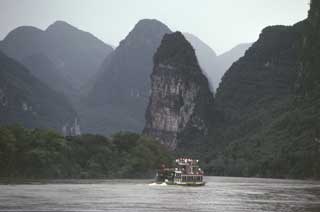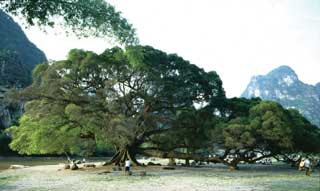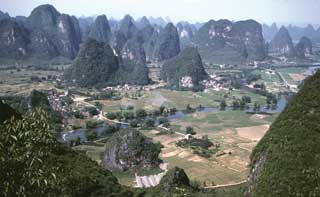| 广西人间天堂:Limestone Paradise | |
| http://www.sina.com.cn 2004/06/07 13:45 中国周刊 | |
In Guangxi there is an area I have frequently referred to as 'Heaven on Earth'. It is the limestone district stretching along the valley of the Li River from the popular tourist city of Guilin to the scenic wonderland of tiny, laid-back, Yangshuo. Produced 300 million years ago when an ancient sea covered this area, the limestone is formed from the compressed fossilised remains of sea creatures. The movements of the continents caused the earth to rise up and the sea disappeared. Since then warm, wet climatic conditions have allowed the rock to be steadily eaten away by chemical weathering and physically worn away by running water. The result is the landscape we have today in this part of Guangxi, a place where art and geology have come together. An area, which has drawn artists and travellers to its attractions in now ever increasing, numbers. Great river journey Reaching Yangshuo from Guilin is one of the great river journeys of the World. Several hours of meandering through a natural wonderland of limestone pinnacles reaching skywards make the Li River unique. Clouds seemed to hang listlessly around their summits while vegetation appears from any level surface on what are otherwise vertical slopes. Sometimes the boat rushes through narrow canyons or else floats gently on broad stretches of water.
A feature of the journey is watching out for the 'cormorant fishermen'. Rafts are made of five large bamboo poles lashed together and slightly upturned at either end. Two men steer the craft with long poles. A circular basket holds the catch. The 'fisherman' is actually a bird: a black cormorant with a ring around its neck to prevent it swallowing the fish. The cormorants dive, catch a fish in their beaks and bring it back to the boat. This sight is most scenic at night when lanterns, used to attract the fish, are suspended from the rafts. Yangshuo is an attractive town sitting in narrow valleys beneath many steep hills. Due to the growth of caféculture and cheap hotels it has attracted many foreign travellers seeking its easy lifestyle while enjoying the scenery. The town does have many fascinating corners to explore off its main street. Alleys entered through moon gates are lined with traditional two-storey houses and local markets. Cycling - the way to appreciate the landscape of Moon Hill For many people the real attraction lies beyond the town in the spectacular natural landscape. Often the best way to experience its beauty is by bicycle. One delightful road leads to the aptly named Moon Hill (yueliangshan) - a great limestone pinnacle with a naturally created moon-shaped passage going through just below its summit. The scenery along the road is dramatic. After winding along a narrow valley lined with rice fields the road emerges where a river from the beautiful Baisha Valley flows out towards the Li Jiang. Towers of limestone, all appearing roughly similar in height, look stunning in the early evening light. A scene enhanced by continual human activity in the fields around the base.
Close to Moon Hill is a delightful area. Just off the road is the 1500-year-old Big Banyan Tree whose branches and roots spread over a large area close to the river. Across the water villages spread themselves around the base of narrow pinnacles. Caves in the rock face have often been turned into natural storage sheds. A causeway spans the river at this point. Although no problem for much of the year, crossing it is difficult when the summer rains are heavy and the brown-coloured water is high. Then, peasants with baskets suspended from bamboo shoulder poles, and trousers rolled up, carefully wade across the strong flow. This area is spectacularly viewed from Moon Hill. Reaching its upper section requires a steep climb up a well-made path through groves of dense bamboo. Once past the vegetation the path enters the great natural opening that distinguishes this hill from its neighbours. Beyond, a steep, narrow track involving some simple scrambling soon leads to the flat, although narrow summit. Further away still, the skyline is lined with peaks of almost equal height - resembling narrow triangles of rock pointing skywards. Most are dark green, being covered with a thick mass of fairly jagged vegetation. The more distant hills are close together, contrasting with the wider spaces around the Baisha Valley. A patchwork of fields, in different stages of growth, produce abundant crops of rice and vegetables. Villages, connected by a network of tracks, keep close to the cliffs so as not to waste valuable farming land. The main road back to Yangshuo lies in the distance, cutting a sweeping path through this serene land. Also below lie the Big Banyan Tree and the areas previously visited. Starting to head back to town, evening was approaching and the area's natural beauty enhanced. Many peaks became silhouettes in the hazy sky. They were reflected in the calm waters of fishponds adjacent to a wide green carpet of maturing rice. There, the river also flowed in a wide bend. Mirrored on its smooth surface was Moon Hill - so beautiful it was difficult to leave that evening. Hidden Baisha Valley The entire area is a delight to explore by mountain bike. The Baisha Valley, for example, was so stunning that almost every minute required a stop to photograph another breathtaking scene. Tracks led through a working landscape of rice fields, fishponds and villages where the houses were built of dried adobe (mud earth) bricks. Vegetable plots sat close to the homes where small pigs often wallowed in mud holes. The route, after winding through a network of adjoining valleys eventually followed the main river. To provide essential irrigation water for the fields, the wide stream was dammed and canals carried fast flowing water to the fields. Arched stone bridges, possibly hundreds of years old, provided access to the rich fields on the other side.
By river to surrounding countryside Riverboats, which can carry bicycles, radiate out from Yangshuo to many small towns where time seems almost to have stood still. From them it is a pleasant cycle ride back to town, the journey usually taking much longer than the distance suggests, due to the requirements of photography. One small, fascinating town whose market held me fascinated for hours is Fuili - about forty minutes downriver. Landing at steps leading up from the river, the town was entered through an old arched gateway. Turning round, it almost seemed like a frame for the picture of the river and distant peaks - scenes that have inspired artists for generations. Another great journey is the struggle upriver against the current. Beneath walls of peaks, bamboo and heavily foliaged trees sway in the breeze as buffaloes graze just above the water's edge. Bamboo rafts lie on the grass at shallow bays where the river bends have become home to small settlements. Life seems all around. Boats are lined up alongside the banks, tied to simple bamboo poles stuck in the mud. Often just planks of wood from the muddy shore lead up to the boats. Cargoes of rice or vegetables are being loaded for the trip to larger river towns. Everything including bicycles seems brought on board by peasants wearing circular straw hats. One journey to be repeated several times is from the pleasant upriver village of Xingping. Cafés and restaurants near the landing stage make a visit there a pleasant experience, but the real interest lies along the road back to Yangshuo. On Xingping's main street rice is frequently spread out to dry. Peasants will then scoop up the grains and store them in sacks for shipment to market. Along the valley beyond the settlement rice is intensively cultivated in the lower fields. Beyond, groves of sugarcane lead to the steeper slopes reserved for grazing or left under trees and scrub bushes. A land dominated by rice The entire route seems dominated by rice - ploughing, transplanting and harvesting. Hard work has produced this landscape. There seems endless human activity in the fields; indeed it is a 'people-centred' landscape. Most equipment employed is what I would call 'intermediate technology', with little in the way of mechanisation.
Earthen banks protect the fields from flooding by the brown water of adjacent streams. However, water is introduced to the soil to soften it up before planting. Buffaloes pulling wooden ploughs or rakes first ready the fields for planting. These animals are the main beast-of-burden and when not working are frequently seen slumbering or rolling in the alluvial thick mud left after harvesting. I stopped and watched a cow walking home from the fields while the peasant-in-charge casually strolled behind. They had just crossed a double-arched stone bridge over a river. Beside the track, straw was bundled up from recent harvesting. Meanwhile peasants continued with the planting in distant fields. On the main road an elderly woman was leading her buffalo back to their village. They had just passed a farmer walking with a large flock of quacking ducks towards a roadside pond. Planting the rice, although a fascinating site for visitors is hard, hot work in the strong sun. Thinking of the term 'back-breaking', I watched two peasants bent over in the mud as they transplanted young, green shoots. Rice, when harvested was put into large foot-operated wooden threshing boxes, where the grain was removed from the stalks. This was also taking place next to fields being planted. This area can produce rice crops almost all year round. although the rice farmers often welcome clouds, photographers wanting bright light do not. However, at one point as I watched two peasants working in a field the clouds parted and a beam of light shone straight onto them. Their images were reflected in the calm waters - an unforgettable memory. Other memories were of children and people who came out to talk to me or just look when I stopped at a roadside shop. So many times in the Yangshuo area I felt I was in Heaven - simply at home with Nature and the incredible human landscape which Man has forced from it. So many images from a place of incredible beauty. By BRUCE CONNOLLY
| |
| 【英语学习论坛】【评论】【大 中 小】【打印】【关闭】 |




